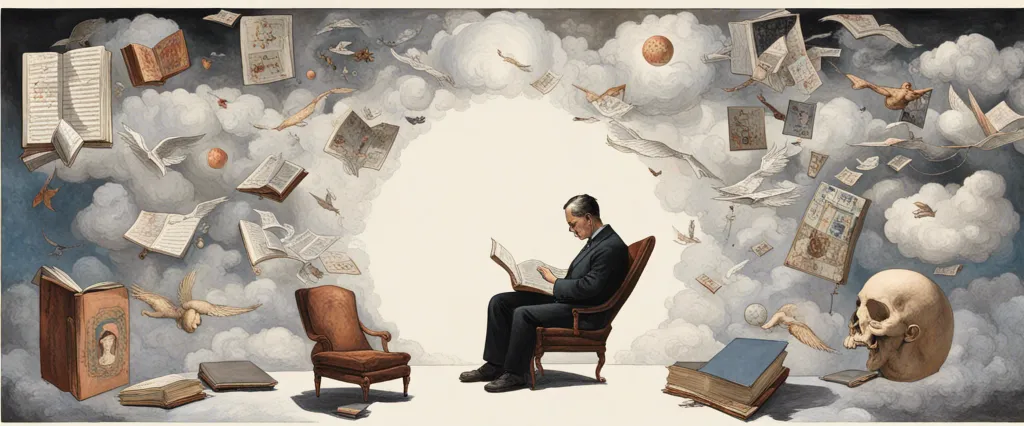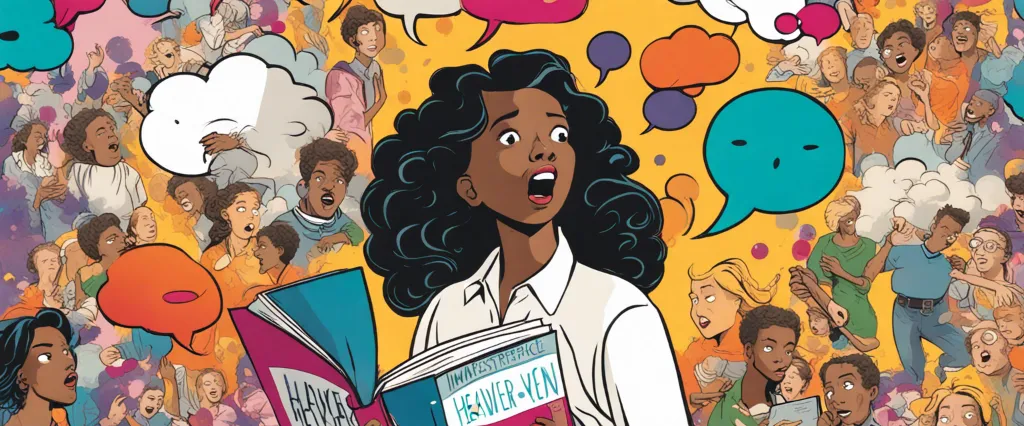
In “Heavier Than Heaven,” Charles R. Cross presents an intimate and deeply researched biography of one of rock music’s most influential and enigmatic figures, Kurt Cobain. Delving into the complex and troubled life of the Nirvana frontman, Cross offers a compelling narrative that explores Cobain’s rise to fame, his battle with personal demons, and the tragic end that left an indelible mark on the music world. With his impeccable research and nuanced storytelling, Cross provides readers with a profound understanding of Cobain’s transformative impact and the lingering legacy he left behind.
Charles R. Cross is a highly regarded journalist and biographer, renowned for his extensive knowledge of the Seattle music scene and his meticulous research. As the former editor for Seattle’s The Rocket magazine, Cross had a front-row seat to witness the rise of grunge music and the birth of Nirvana. His previous works, including biographies of Jimi Hendrix and Bruce Springsteen, have earned him critical acclaim for his ability to delve deep into the lives of iconic musicians and capture their essence with precision and empathy. With “Heavier Than Heaven,” Cross solidifies his position as one of the foremost authorities on the life and artistry of Kurt Cobain.
Chapter 1: Early Life and Childhood
Chapter 1 of “Heavier Than Heaven” by Charles R. Cross explores the early life and childhood of Kurt Cobain, the lead singer of the iconic rock band Nirvana. The chapter paints a detailed picture of Cobain’s formative years, providing insight into his complex personality and the factors that shaped his artistry.
The chapter begins by describing Cobain’s lineage, tracing his family roots back to Northern Ireland and shedding light on the turbulent history of his ancestors. It then delves into Cobain’s parents, Don and Wendy Cobain, and their troubled relationship. The reader learns about Don’s volatile temperament and drug abuse, which greatly impacted the household dynamics.
Cross then zooms in on Cobain’s own childhood, highlighting his hyperactive nature and artistic inclinations from a young age. The author emphasizes Cobain’s difficulties in fitting into the standard educational system due to his unique mindset and relentless creative drive. Cobain’s talent for drawing and music emerged early, and his passionate interest in the arts provided an escape from the chaos of his home life.
Throughout the chapter, Cross explores the essence of Cobain’s personality, discussing his sensitivity and empathetic nature. Cobain’s compassion for others, particularly animals, is emphasized as a key aspect of his character.
Overall, Chapter 1 of “Heavier Than Heaven” presents a glimpse into Cobain’s troubled upbringing and the environmental factors that influenced his development as an artist. The chapter sets the foundation for understanding the struggles and complexities that would shape Cobain’s life and ultimately contribute to his tragic demise.
Chapter 2: Rise to Fame
Chapter 2: Rise to Fame of the book Heavier Than Heaven by Charles R. Cross follows the life and career of musician Kurt Cobain, focusing on his journey from obscurity to stardom. The chapter starts by detailing Cobain’s early struggles as a teenager, dealing with a broken home and a tumultuous relationship with his parents. Despite these challenges, Cobain finds solace in music and begins to express himself through writing and performing.
As Cobain enters adulthood, he forms his first band, Fecal Matter, which foreshadows the creation of Nirvana. Cross describes the band’s early sound and their relentless determination to make it big. Cobain’s talent and originality start to gain attention, and he becomes known for his unique voice and songwriting abilities.
The chapter then delves into the formation of Nirvana, the iconic grunge band that would propel Cobain to unprecedented fame. Cross explores the dynamics within the band, highlighting the creative process and the tension between Cobain and his bandmates.
As Nirvana gains momentum, they sign a major record deal with DGC Records and release their breakthrough album, “Nevermind.” The chapter examines the impact of the album and its lead single, “Smells Like Teen Spirit,” which catapults the band to global success.
Lastly, Cross details the subsequent effects of fame on Cobain’s mental health. He begins to struggle with addiction, depression, and the pressures of celebrity life. The chapter ends on a somber note, foreshadowing the challenges and tragedy that await Cobain in the future.
Overall, Chapter 2: Rise to Fame chronicles Kurt Cobain’s journey from troubled beginnings to becoming one of rock’s most iconic figures, and sets the stage for the subsequent chapters, which will delve deeper into the complexities of his life and tragic end.
Chapter 3: Struggles with Addiction
Chapter 3 of “Heavier Than Heaven” by Charles R. Cross delves into the struggles that the legendary musician Kurt Cobain faced with addiction throughout his life. The chapter explores how Cobain’s addiction to drugs and alcohol influenced his personal relationships, his creativity, and ultimately contributed to his tragic demise.
Cross begins by describing Cobain’s first taste of drugs at a young age, experimenting with marijuana and eventually moving on to harder substances. As Cobain’s drug use escalated, his behavior became increasingly erratic and self-destructive. He struggled with feelings of alienation and sought solace in substance abuse as a means of escaping his troubled mind.
Cobain’s addiction had a significant impact on his relationships, particularly with his high school sweetheart and first wife, Tracy Marander. Cross highlights how Marander’s growing frustration and concern for Cobain’s well-being eventually led to their separation. Additionally, Cobain’s substance abuse strained his relationships with bandmates and managers, as they were frequently forced to deal with his crippling addiction.
The chapter provides insights into the intersection of Cobain’s addiction and his burgeoning musical career. As Cobain’s fame grew with the success of Nirvana, the pressure and demands of his rockstar lifestyle further fueled his addiction. His continued substance abuse affected his ability to perform consistently and contributed to the band’s tumultuous tours.
Ultimately, Cross explores the profound impact of Cobain’s addiction on his mental health and the eventual tragedy that unfolded. Cobain’s battle with addiction and depression became increasingly intense, leading to several episodes of self-harm and suicide attempts.
In summary, Chapter 3 of “Heavier Than Heaven” delves into Kurt Cobain’s struggles with addiction, exploring how it affected his relationships, creativity, and ultimately played a significant role in his untimely death. The chapter offers a poignant and heartbreaking examination of the consequences of substance abuse on an artist and their journey towards self-destruction.
Chapter 4: Creative Process and Songwriting

Chapter 4 of “Heavier Than Heaven” by Charles R. Cross explores the creative process and songwriting of Kurt Cobain, the lead singer and songwriter of the influential band Nirvana. The chapter delves into the personal experiences, inspirations, and musical influences that shaped Cobain’s approach to songwriting.
Cross provides a glimpse into Cobain’s early life, highlighting the impact of his parents’ divorce and subsequent turbulent relationships on his music. Cobain’s troubled childhood and adolescent years fueled his introspective and melancholic songwriting style, which resonated with a generation grappling with similar emotions.
The chapter explores Cobain’s musical roots, tracing the evolution of his songwriting from his early punk influences through to his discovery of bands like the Melvins and the Pixies. Cobain’s love for punk rock, combined with his exposure to alternative and underground music scenes, shaped his unique blend of distorted guitar riffs, raw lyrics, and emotional vulnerability.
Cross also delves into Cobain’s creative process, describing how he would often write lyrics and musical ideas separately, carefully combining them to create cohesive songs. Cobain’s songs often tackled topics like depression, social alienation, and personal struggles, providing a cathartic outlet for himself and his listeners.
Furthermore, the chapter explores Cobain’s collaborative songwriting process within Nirvana, highlighting how his bandmates contributed to the creation of their iconic sound. The collective effort to refine and arrange the songs demonstrated Cobain’s willingness to experiment and incorporate different perspectives into his compositions.
In summary, Chapter 4 of “Heavier Than Heaven” offers insights into Kurt Cobain’s creative process and songwriting journey, emphasizing the personal, musical, and collaborative elements that contributed to his influential body of work.
Chapter 5: Relationships and Love Life
Chapter 5: Relationships and Love Life of the book “Heavier Than Heaven” by Charles R. Cross dives into the tumultuous romantic relationships in the life of Kurt Cobain, the legendary frontman of Nirvana. This chapter explores the early years of his love life, as well as significant relationships that shaped his career and personal struggles.
The chapter begins by detailing Cobain’s teenage years, during which he struggled with feelings of isolation and loneliness. His first serious relationship was with Tracy Marander, with whom he lived in a small apartment in Olympia, Washington. Marander supported Cobain financially and emotionally, enabling him to focus on his music. However, their relationship eventually crumbled under the weight of his drug use and emotional instability.
Following the dissolution of his relationship with Marander, Cobain met Courtney Love, the lead singer of the band Hole. Initially, they bonded over their shared passion for music and their troubled backgrounds. Love became Cobain’s muse, influencing his lyrics and artistic direction. Their relationship quickly turned passionate, marked by a whirlwind of love, drug abuse, and controversy.
Cross delves into how Cobain’s relationship with Love was both passionate and deeply problematic. They struggled with drug addiction, media scrutiny, and personal demons that drove a wedge between them. Despite their undeniable love for each other, their relationship was plagued by arguments, infidelity, and self-destructive behavior. Cross suggests that their troubled dynamic played a significant role in Cobain’s worsening mental state.
Overall, Chapter 5 of “Heavier Than Heaven” explores Kurt Cobain’s relationships, highlighting the impact they had on his life and creative work. It offers a glimpse into the complex and troubled love life of a musical icon, shedding light on the struggles he faced both personally and artistically.
Chapter 6: Nirvana’s Success and Impact
Chapter 6: Nirvana’s Success and Impact of the book Heavier Than Heaven by Charles R. Cross delves into the groundbreaking success of the band Nirvana and its profound impact on the music industry and popular culture.
The chapter begins by illustrating the rapid rise of Nirvana, tracing their journey from a Seattle grunge band to global icons. Fueled by their groundbreaking album “Nevermind” and the hit single “Smells Like Teen Spirit,” Nirvana’s success was unparalleled. The book highlights how their success not only defined an era but also transformed the entire music landscape.
Cross explores how Nirvana’s success represented a seismic shift in the music industry, as the band challenged the dominance of hair metal bands and brought alternative rock to the mainstream. The chapter also details the band’s legendary performance on MTV’s “Unplugged,” which showcased their versatility and raw talent.
Furthermore, Cross delves into the impact Nirvana had on a societal level. Nirvana’s lyrics, covering themes of depression, anger, and alienation, resonated with a generation grappling with similar emotions. The band became the emblem of the grunge movement, capturing the disillusionment and frustration of many young people in the early ’90s.
The chapter concludes by highlighting the tragic end of Nirvana and frontman Kurt Cobain’s life, which came as a shock to their legions of fans. The book explores the impact of Cobain’s death on both the music industry and the millions of people who connected deeply with his music.
Overall, Chapter 6 of Heavier Than Heaven provides a comprehensive account of Nirvana’s phenomenal success and their profound impact on music and culture. It captures the essence of a band that changed the trajectory of rock and left an indelible mark on the world.
Chapter 7: Tragic End and Legacy
Chapter 7 of “Heavier Than Heaven” by Charles R. Cross, titled “Tragic End and Legacy,” delves into the final days of Kurt Cobain, the iconic frontman of the band Nirvana, and the impact of his untimely death on the music world.
The chapter begins by recounting the events leading up to Cobain’s suicide on April 5, 1994. It explores his battle with depression, drug addiction, and the strained state of his marriage with Courtney Love. The narrative presents a detailed account of the discovery of Cobain’s body, the police investigation, and the subsequent media frenzy surrounding his death.
Cross delves into the aftermath of Cobain’s suicide, touching upon the emotional devastation experienced by his friends, family, and fans. He explores how the loss of Cobain affected the grunge music scene and how it became a symbol for the struggles of a generation.
Furthermore, Cross delves into the debates and conspiracy theories that emerged after Cobain’s death. Some suggested foul play or doubted the official cause of suicide. However, thorough investigations and evidence pointed to the tragic end of Cobain’s life, tarnishing the air of mystique that had surrounded his death.
The chapter concludes by examining Cobain’s lasting legacy. Cross delves into the ways Cobain’s music and message resonated with people, especially those who felt marginalized or alienated. He explores how Cobain’s influence continues to shape contemporary music and art, and how his death has perpetuated his status as a misunderstood tortured artist.
In summary, Chapter 7 of “Heavier Than Heaven” chronicles the events leading up to Kurt Cobain’s tragic death, the immediate aftermath, and the lasting impact on music history and the cultural landscape.

Chapter 8: Remembering the Legend
Chapter 8 of “Heavier Than Heaven” by Charles R. Cross delves into the tragic life of Kurt Cobain, the frontman of the influential band Nirvana. Titled “Remembering the Legend,” this chapter emphasizes the impact Kurt’s music had on his fans, despite his struggles with addiction and mental health.
Cross begins by highlighting Cobain’s ability to connect with his audience through his music. Fans often found solace in Nirvana’s songs, which spoke to their own feelings of anger, isolation, and confusion. Cobain’s raw lyrics and powerful performances resonated deeply with his followers, solidifying his status as a musical legend.
The chapter then delves into Cobain’s internal conflicts and constant battle with drug addiction. It explores his early experimentation with drugs and how it escalated as his fame grew. Cross also touches on the severe stomach pain that plagued Cobain, leading him to seek relief through self-medication. The author provides an intimate account of Kurt’s struggle to overcome addiction while attempting to balance his personal demons and creative pursuits.
Additionally, Cross examines Cobain’s relationships, particularly his marriage to Courtney Love and his tumultuous relationship with fame. Despite the mutual love and admiration between the couple, their drug use and personal troubles intensified their struggles and ultimately contributed to the unraveling of their marriage.
In “Remembering the Legend,” Cross paints a picture of Kurt Cobain as both a musical genius and a tormented soul. This chapter serves to underline the complex nature of Cobain’s life, showcasing the dichotomy between the influence he had as a musician and the personal battles he faced behind the scenes.
After Reading
In conclusion, “Heavier Than Heaven” by Charles R. Cross is a deeply insightful and emotive biography that delves into the complex life of Kurt Cobain, the iconic frontman of Nirvana. Through meticulous research and interviews with those closest to Cobain, Cross paints a vivid portrait of the troubled musician’s early years, rise to fame, and ultimately, his tragic demise. This biography not only explores Cobain’s musical greatness but also delves into his struggles with mental health, addiction, and the pressures of fame. Cross offers readers a comprehensive and intimate understanding of Cobain’s inner turmoil, while simultaneously honoring his undeniable impact on the music industry. Ultimately, “Heavier Than Heaven” serves as a poignant exploration of the highs and lows of Cobain’s life, leaving readers with a profound sense of loss for a talent gone too soon.
1. “The Kite Runner” by Khaled Hosseini – This emotionally gripping novel tells the story of Amir, a young boy from Afghanistan, and his journey of guilt and redemption. It explores themes of friendship, betrayal, and the trials of growing up in a war-torn country.
2. The Great Gatsby” by F. Scott Fitzgerald – Set in the Roaring Twenties, this classic depicts the glamorous and decadent lives of New York’s elite. It follows Jay Gatsby, a mysterious millionaire, and his pursuit of his lost love, Daisy Buchanan. Fitzgerald’s beautiful prose and portrayal of the American Dream make this a must-read.
3. “To Kill a Mockingbird” by Harper Lee – This beloved classic addresses challenging topics such as racial inequality and injustice through the eyes of Scout, a young girl growing up in the southern United States during the 1930s. Lee’s poignant storytelling, memorable characters, and exploration of moral courage make this book both powerful and timeless.
4. “The Handmaid’s Tale” by Margaret Atwood – Set in a dystopian future, this thought-provoking novel tells the story of Offred, a Handmaid forced to serve a wealthy family for reproductive purposes. Atwood’s chilling depiction of a society where women’s rights have been stripped away raises important questions about power, control, and gender dynamics.
5. “The Catcher in the Rye” by J.D. Salinger – Narrated by Holden Caulfield, a disillusioned teenager, this iconic coming-of-age novel explores themes of identity, alienation, and the phoniness of society. Salinger’s unique narrative style and honest portrayal of adolescence have made this book a classic that resonates with generations of readers.



